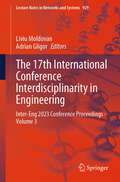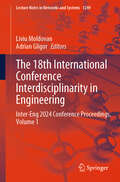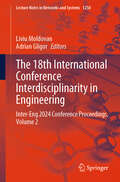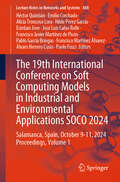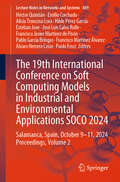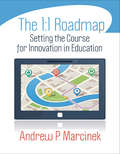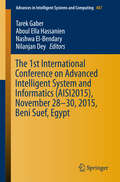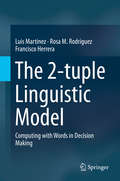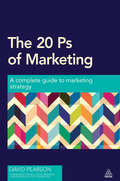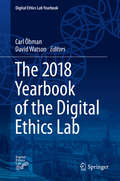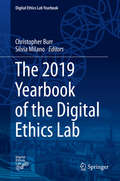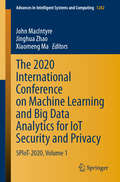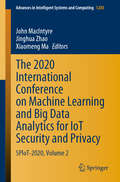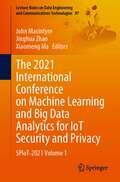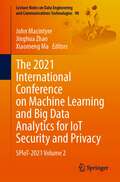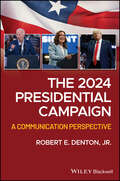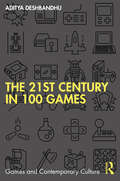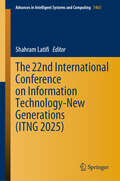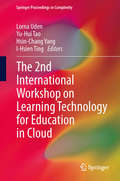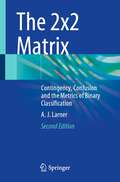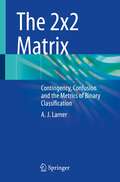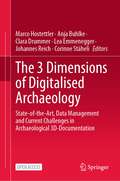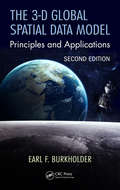- Table View
- List View
The 17th International Conference Interdisciplinarity in Engineering: Inter-Eng 2023 Conference Proceedings - Volume 3 (Lecture Notes in Networks and Systems #929)
by Liviu Moldovan Adrian GligorThis book contains research papers that were accepted for presentation at the 17th International Conference on Interdisciplinarity in Engineering—INTER-ENG 2023, which was held on 5–6 October 2023, in the city of Târgu Mureș, Romania. The general scope of the conference “Towards transition for a more competitive European industry in a smart, safe and sustainable future” is proposing a new approach related to the development of a new generation of smart factories grounded on the manufacturing and assembly process digitalization. It is related to advance manufacturing technology, lean manufacturing, sustainable manufacturing, additive manufacturing, manufacturing tools and equipment. It is a leading international professional and scientific forum of great interest for engineers and scientists who can read in this book research works contributions and recent developments as well as current practices in advanced fields of engineering.
The 18th International Conference Interdisciplinarity in Engineering: Inter-Eng 2024 Conference Proceedings, Volume 1 (Lecture Notes in Networks and Systems #1249)
by Liviu Moldovan Adrian GligorThis book contains research papers that were accepted for presentation at the 18th International Conference on Interdisciplinarity in Engineering—INTER-ENG 2024, which was held on 3–4 October 2024, in the city of Targu Mures, Romania. The general scope of the conference “An effective digital-green transition for a more competitive European industry” is proposing a new approach related to the development of a new generation of smart factories grounded on the manufacturing and assembly process digitalization. It is related to advance manufacturing technology, lean manufacturing, sustainable manufacturing, additive manufacturing, manufacturing tools and equipment. It is a leading international professional and scientific forum of great interest for engineers and scientists who can read in this book research works contributions and recent developments as well as current practices in advanced fields of engineering.
The 18th International Conference Interdisciplinarity in Engineering: Inter-Eng 2024 Conference Proceedings, Volume 2 (Lecture Notes in Networks and Systems #1250)
by Liviu Moldovan Adrian GligorThis book contains research papers that were accepted for presentation at the 18th International Conference on Interdisciplinarity in Engineering—INTER-ENG 2024, which was held on 3–4 October 2024, in the city of Targu Mures, Romania. The general scope of the conference “An effective digital-green transition for a more competitive European industry” is proposing a new approach related to the development of a new generation of smart factories grounded on the manufacturing and assembly process digitalization. It is related to advance manufacturing technology, lean manufacturing, sustainable manufacturing, additive manufacturing, manufacturing tools and equipment. It is a leading international professional and scientific forum of great interest for engineers and scientists who can read in this book research works contributions and recent developments as well as current practices in advanced fields of engineering.
The 19th International Conference on Soft Computing Models in Industrial and Environmental Applications SOCO 2024: Salamanca, Spain, October 9-11, 2024 Proceedings, Volume 1 (Lecture Notes in Networks and Systems #888)
by Héctor Quintián Emilio Corchado Francisco Javier Martínez de Pisón Hilde Pérez García Francisco Martínez Álvarez Alicia Troncoso Lora Pablo García Bringas Esteban Jove José Luis Calvo Rolle Paolo Fosci Álvaro Herrero CosíoThis volume of Advances in Intelligent and Soft Computing contains accepted papers presented at the SOCO 2024 conference held in the beautiful and historic city of Salamanca (Spain) in October 2024. Soft computing represents a collection or set of computational techniques in machine learning, computer science, and some engineering disciplines that investigate, simulate, and analyze very complex issues and phenomena. After a thorough peer-review process, the 18th SOCO 2023 International Program Committee selected 62 papers for publication in these conference proceedings, representing an acceptance rate of 50%. In this relevant edition, a particular emphasis was put on organizing special sessions. Four special sessions were organized related to relevant topics such as Machine Learning and Computer Vision in Industry 4.0, Intelligent Models and Frameworks for Smart Agriculture and Green Economy, Computational Intelligence Applied to Modelling and Control of Engineering Systems, and Applied Machine Learning (2nd Edition). The selection of papers was extremely rigorous to maintain the high quality of the conference. We want to thank the members of the Program Committees for their hard work during the reviewing process. This is a crucial process for creating a high-standard conference; the SOCO conference would not exist without their help.
The 19th International Conference on Soft Computing Models in Industrial and Environmental Applications SOCO 2024: Salamanca, Spain, October 9-11, 2024 Proceedings, Volume 2 (Lecture Notes in Networks and Systems #889)
by Héctor Quintián Emilio Corchado Francisco Javier Martínez de Pisón Hilde Pérez García Francisco Martínez Álvarez Alicia Troncoso Lora Pablo García Bringas Esteban Jove José Luis Calvo Rolle Paolo Fosci Álvaro Herrero CosíoThis volume of Advances in Intelligent and Soft Computing contains accepted papers presented at the SOCO 2024 conference held in the beautiful and historic city of Salamanca (Spain) in October 2024. Soft computing represents a collection or set of computational techniques in machine learning, computer science, and some engineering disciplines that investigate, simulate, and analyze very complex issues and phenomena. After a thorough peer-review process, the 18th SOCO 2023 International Program Committee selected 62 papers for publication in these conference proceedings, representing an acceptance rate of 50%. In this relevant edition, a particular emphasis was put on organizing special sessions. Four special sessions were organized related to relevant topics such as Machine Learning and Computer Vision in Industry 4.0, Intelligent Models and Frameworks for Smart Agriculture and Green Economy, Computational Intelligence Applied to Modelling and Control of Engineering Systems, and Applied Machine Learning (2nd Edition). The selection of papers was extremely rigorous to maintain the high quality of the conference. We want to thank the members of the Program Committees for their hard work during the reviewing process. This is a crucial process for creating a high-standard conference; the SOCO conference would not exist without their help.
The 1: Setting the Course for Innovation in Education
by Andrew P. MarcinekTechnology is more than just “Computer Class;” it is a literacy that must be threaded throughout the fabric of a school. In a 1:1 environment, you’re preparing students to be responsible citizens of the physical and digital worlds. But it’s easy to get overwhelmed with devices; you have to have a plan for technology that keeps learning at center stage. Here you’ll find a solid plan for designing a technology initiative that fuels student learning. Real-life examples, lessons, and interviews with stakeholders show you Why a 1:1 program is not only achievable but also beneficial and necessary How to choose the right devices The best ways to prepare teachers through professional development Best practices for instruction and personalization in a 1:1 environment It’s more essential than ever to integrate digital and information literacy into the fabric of our schools. This practical resource will get you started on the journey.
The 1: Setting the Course for Innovation in Education
by Andrew P. MarcinekTechnology is more than just “Computer Class;” it is a literacy that must be threaded throughout the fabric of a school. In a 1:1 environment, you’re preparing students to be responsible citizens of the physical and digital worlds. But it’s easy to get overwhelmed with devices; you have to have a plan for technology that keeps learning at center stage. Here you’ll find a solid plan for designing a technology initiative that fuels student learning. Real-life examples, lessons, and interviews with stakeholders show you Why a 1:1 program is not only achievable but also beneficial and necessary How to choose the right devices The best ways to prepare teachers through professional development Best practices for instruction and personalization in a 1:1 environment It’s more essential than ever to integrate digital and information literacy into the fabric of our schools. This practical resource will get you started on the journey.
The 1st International Conference on Advanced Intelligent System and Informatics (AISI2015), November 28-30, 2015, Beni Suef, Egypt
by Aboul Ella Hassanien Tarek Gaber Nashwa El-Bendary Nilanjan DeyThe conference topics address different theoretical and practicalaspects, and implementing solutions for intelligent systems and informaticsdisciplines including bioinformatics, computer science, medical informatics,biology, social studies, as well as robotics research. The conference alsodiscuss and present solutions to the cloud computing and big data miningwhich are considered hot research topics. The conference papers discusseddifferent topics - techniques, models, methods, architectures, as well as multiaspect, domain-specific, and new solutions for the above disciplines. Theaccepted papers have been grouped into five parts: Part I--Intelligent Systems and Informatics, addressing topics including,but not limited to, medical application, predicting student performance, actionclassification, and detection of dead stained microscopic cells, opticalcharacter recognition, plant identification, rehabilitation of disabled people. Part II--Hybrid Intelligent Systems, addressing topics including, but notlimited to, EMG signals, text classification, geomagnetic inverse problem,email filtering. Part III--Multimedia Computing and Social Networks, addressing topics including,but not limited to, augmented reality, telepresence robot, video flash matting,community detection, quality images, face thermal image extraction, MRI tumorsegmentation. Part V--Cloud Computing and Big Data Mining, discussing topics including,but not limited to, mining on microblogs, query optimization, big dataclassification, access control, friendsourcing, and assistive technology. Part VI--Swarm Optimization and Its Applications, addressing topicsincluding, but not limited to, solving set covering problem, adaptive PSO forCT liver segmentation, water quality assessment, attribute reduction, fish detection,solving manufacturing cell design problem.
The 2-tuple Linguistic Model
by Francisco Herrera Luis Martínez Rosa M. RodriguezThis book examines one of the more common and wide-spread methodologies to deal with uncertainty in real-world decision making problems, the computing with words paradigm, and the fuzzy linguistic approach. The 2-tuple linguistic model is the most popular methodology for computing with words (CWW), because it improves the accuracy of the linguistic computations and keeps the interpretability of the results. The authors provide a thorough review of the specialized literature in CWW and highlight the rapid growth and applicability of the 2-tuple linguistic model. They explore the foundations and methodologies for CWW in complex frameworks and extensions. The book introduces the software FLINTSTONES that provides tools for solving linguistic decision problems based on the 2-tuple linguistic model. Professionals and researchers working in the field of classification or fuzzy sets and systems will find The 2-tuple Linguistic Model: Computing with Words in Decision Making a valuable resource. Undergraduate and postdoctoral students studying computer science and statistics will also find this book a useful study guide.
The 20 Ps of Marketing
by David PearsonMarketing has changed dramatically since the four classic Ps of the marketing mix (price, product, promotion and place) were proposed. The new marketing landscape is characterised by the demand for constant innovation, rising pressure on budgets, the growth of social media and the impact of issues of sustainability and ethical issues. As the business landscape has transformed so have the fundamental areas marketers need to master to succeed.The 20 Ps of Marketing provides a thorough guide to marketers at all levels of the new elements of the marketing mix they need to contend with for business success including: planning; persuasion; publicity; positioning; productivity; partnerships; passion and more. Combining practical advice with case studies it covers brands that have changed the game through mastery of the 20 Ps such as H agen Daz and Sony, and others, such as Kodak, who got left behind.This essential guide to the current face of marketing strategy provides marketers with a thorough and valuable grounding to the new fundamentals of marketing.
The 2013 Legal Technology Guide Solo and Small Firm
by Sharon D. Nelson John W. Simek Michael C. MaschkeThis annual guide is the only one of its kind written to help solo and small firm lawyers find the best technology for their dollar. You'll find the most current information and recommendations on computers, servers, networking equipment, legal software, printers, security products, smartphones, the iPad and anything else a law office might need. It's written in clear, easily understandable language to make implementation easier if you choose to do it yourself, or you can use it in conjunction with your IT consultant. Either way, you'll learn how to make technology work for you
The 2018 Yearbook of the Digital Ethics Lab (Digital Ethics Lab Yearbook #1)
by David Watson Carl ÖhmanThis book explores a wide range of topics in digital ethics. It features 11 chapters that analyze the opportunities and the ethical challenges posed by digital innovation, delineate new approaches to solve them, and offer concrete guidance to harness the potential for good of digital technologies. The contributors are all members of the Digital Ethics Lab (the DELab), a research environment that draws on a wide range of academic traditions.The chapters highlight the inherently multidisciplinary nature of the subject, which cannot be separated from the epistemological foundations of the technologies themselves or the political implications of the requisite reforms. Coverage illustrates the importance of expert knowledge in the project of designing new reforms and political systems for the digital age. The contributions also show how this task requires a deep self-understanding of who we are as individuals and as a species.The questions raised here have ancient -- perhaps even timeless -- roots. The phenomena they address may be new. But, the contributors examine the fundamental concepts that undergird them: good and evil, justice and truth. Indeed, every epoch has its great challenges. The role of philosophy must be to redefine the meaning of these concepts in light of the particular challenges it faces. This is true also for the digital age. This book takes an important step towards redefining and re-implementing fundamental ethical concepts to this new era.
The 2019 Yearbook of the Digital Ethics Lab (Digital Ethics Lab Yearbook)
by Christopher Burr Silvia MilanoThis edited volume presents an overview of cutting-edge research areas within digital ethics as defined by the Digital Ethics Lab of the University of Oxford. It identifies new challenges and opportunities of influence in setting the research agenda in the field.The yearbook presents research on the following topics: conceptual metaphor theory, cybersecurity governance, cyber conflicts, anthropomorphism in AI, digital technologies for mental healthcare, data ethics in the asylum process, AI’s legitimacy and democratic deficit, digital afterlife industry, automatic prayer bots, foresight analysis and the future of AI. This volume appeals to students, researchers and professionals.
The 2020 International Conference on Machine Learning and Big Data Analytics for IoT Security and Privacy: SPIoT-2020, Volume 1 (Advances in Intelligent Systems and Computing #1282)
by John MacIntyre Jinghua Zhao Xiaomeng MaThis book presents the proceedings of The 2020 International Conference on Machine Learning and Big Data Analytics for IoT Security and Privacy (SPIoT-2020), held in Shanghai, China, on November 6, 2020. Due to the COVID-19 outbreak problem, SPIoT-2020 conference was held online by Tencent Meeting. It provides comprehensive coverage of the latest advances and trends in information technology, science and engineering, addressing a number of broad themes, including novel machine learning and big data analytics methods for IoT security, data mining and statistical modelling for the secure IoT and machine learning-based security detecting protocols, which inspire the development of IoT security and privacy technologies. The contributions cover a wide range of topics: analytics and machine learning applications to IoT security; data-based metrics and risk assessment approaches for IoT; data confidentiality and privacy in IoT; and authentication and access control for data usage in IoT. Outlining promising future research directions, the book is a valuable resource for students, researchers and professionals and provides a useful reference guide for newcomers to the IoT security and privacy field.
The 2020 International Conference on Machine Learning and Big Data Analytics for IoT Security and Privacy: SPIoT-2020, Volume 2 (Advances in Intelligent Systems and Computing #1283)
by John MacIntyre Jinghua Zhao Xiaomeng MaThis book presents the proceedings of The 2020 International Conference on Machine Learning and Big Data Analytics for IoT Security and Privacy (SPIoT-2020), held in Shanghai, China, on November 6, 2020. Due to the COVID-19 outbreak problem, SPIoT-2020 conference was held online by Tencent Meeting. It provides comprehensive coverage of the latest advances and trends in information technology, science and engineering, addressing a number of broad themes, including novel machine learning and big data analytics methods for IoT security, data mining and statistical modelling for the secure IoT and machine learning-based security detecting protocols, which inspire the development of IoT security and privacy technologies. The contributions cover a wide range of topics: analytics and machine learning applications to IoT security; data-based metrics and risk assessment approaches for IoT; data confidentiality and privacy in IoT; and authentication and access control for data usage in IoT. Outlining promising future research directions, the book is a valuable resource for students, researchers and professionals and provides a useful reference guide for newcomers to the IoT security and privacy field.
The 2021 International Conference on Machine Learning and Big Data Analytics for IoT Security and Privacy: SPIoT-2021 Volume 1 (Lecture Notes on Data Engineering and Communications Technologies #97)
by John Macintyre Jinghua Zhao Xiaomeng MaThis book presents the proceedings of the 2020 2nd International Conference on Machine Learning and Big Data Analytics for IoT Security and Privacy (SPIoT-2021), online conference, on 30 October 2021. It provides comprehensive coverage of the latest advances and trends in information technology, science and engineering, addressing a number of broad themes, including novel machine learning and big data analytics methods for IoT security, data mining and statistical modelling for the secure IoT and machine learning-based security detecting protocols, which inspire the development of IoT security and privacy technologies. The contributions cover a wide range of topics: analytics and machine learning applications to IoT security; data-based metrics and risk assessment approaches for IoT; data confidentiality and privacy in IoT; and authentication and access control for data usage in IoT. Outlining promising future research directions, the book is a valuable resource for students, researchers and professionals and provides a useful reference guide for newcomers to the IoT security and privacy field.
The 2021 International Conference on Machine Learning and Big Data Analytics for IoT Security and Privacy: SPIoT-2021 Volume 2 (Lecture Notes on Data Engineering and Communications Technologies #98)
by John Macintyre Jinghua Zhao Xiaomeng MaThis book presents the proceedings of the 2020 2nd International Conference on Machine Learning and Big Data Analytics for IoT Security and Privacy (SPIoT-2021), online conference, on 30 October 2021. It provides comprehensive coverage of the latest advances and trends in information technology, science and engineering, addressing a number of broad themes, including novel machine learning and big data analytics methods for IoT security, data mining and statistical modelling for the secure IoT and machine learning-based security detecting protocols, which inspire the development of IoT security and privacy technologies. The contributions cover a wide range of topics: analytics and machine learning applications to IoT security; data-based metrics and risk assessment approaches for IoT; data confidentiality and privacy in IoT; and authentication and access control for data usage in IoT. Outlining promising future research directions, the book is a valuable resource for students, researchers and professionals and provides a useful reference guide for newcomers to the IoT security and privacy field.
The 2024 Presidential Campaign: A Communication Perspective
by Robert E. Denton Jr.A comprehensive communication analysis of the 2024 presidential campaign Presidential campaigns are more than elections, they are cultural touchstones that shape national identity and political discourse. The 2024 presidential campaign was a defining moment in American history, marked by political polarization and cultural turns. In The 2024 Presidential Campaign: A Communication Perspective Robert E. Denton, Jr. and a team of esteemed scholars offer an incisive look at the strategies, narratives, and media that influenced this landmark election. Examining all key areas of the 2024 election through the lens of communication, this timely volume delves into critical facets of campaign messaging, including political advertising and established news media. Discussions of recent developments such as AI-generated content and the expansion of alternative media provide a deeper understanding of how rapid technological advancement impacts both presidential campaigns and American democracy. Each chapter provides unique insights, connecting communication theory to real-world electoral phenomena. Presents in-depth analyses of televised debates, social media strategies, and advertising Explores the use of humor in computer-generated images and political cartoons Includes chapters on candidate branding and political party conventions Addresses the impact of campaign finance on electoral outcomes Offers the latest insights into digital and mediated campaign practices Provides a unique perspective on cultural and generational shifts in U.S. politics The 2024 Presidential Campaign: A Communication Perspective is essential reading for scholars and students in Political Science, Journalism, and Communication, particularly those studying presidential campaigns, media and politics, and the presidency. Ideal for upper-level undergraduate and graduate courses, it is also a valuable resource for professionals in political campaign management.
The 21st Century in 100 Games (Games and Contemporary Culture)
by Aditya DeshbandhuThe 21st Century in 100 Games is an interactive public history of the contemporary world. It creates a ludological retelling of the 21st century through 100 games that were announced, launched, and played from the turn of the century. The book analyzes them and then uses the games as a means of entry to examine both key events in the 21st century and the evolution of the gaming industry. Adopting a tri-pronged perspective — the reviewer, the academic, and an industry observer — it studies games as ludo-narratological artefacts and resituates games in a societal context by examining how they affect and are engaged with by players, reviewers, the gaming community, and the larger gaming industry.This book will be a must read for readers interested in video games, new media, digital culture (s), culture studies, and history.
The 22nd International Conference on Information Technology-New Generations (Advances in Intelligent Systems and Computing #1463)
by Shahram LatifiThis book covers technical contributions that have been submitted, reviewed and presented at the 22nd annual event of International conference on Information Technology: New Generations (ITNG) The applications of advanced information technology to such domains as astronomy, biology, education, geosciences, security and health care are among topics of relevance to ITNG. Visionary ideas, theoretical and experimental results, as well as prototypes, designs, and tools that help the information readily flow to the user are of special interest. Machine Learning, Robotics, High Performance Computing, and Innovative Methods of Computing are examples of related topics.
The 2nd International Workshop on Learning Technology for Education in Cloud
by Lorna Uden I-Hsien Ting Hsin-Chang Yang Yu-Hui TaoProceedings from the 2013 LTEC conference in Kaohsiung, Taiwan. The papers examine diverse aspects of Learning Technology for Education in Cloud environments, including social, technical and infrastructure implications. Also addressed is the question of how cloud computing can be used to design applications to support real time on demand learning using technologies. The workshop proceedings provide opportunities for delegates to discuss the latest research in TEL (Technology Enhanced Learning) and its impacts for learners and institutions, using cloud technologies.
The 2x2 Matrix: Contingency, Confusion and the Metrics of Binary Classification
by A. J. LarnerThis book describes, extends, and illustrates the metrics of binary classification through worked examples.Worked examples based on pragmatic test accuracy study data are used in chapters to illustrate relevance to day-to-day clinical practice. Readers will gain an understanding of sensitivity and specificity and predictive values along with many other parameters.The contents are highly structured, and the use of worked examples facilitates understanding and interpretation.This book is a resource for clinicians in any discipline who are involved in the performance or assessment of test accuracy studies and professionals in the disciplines of machine learning or informatics wishing to gain insight into clinical applications of 2x2 tables.
The 2x2 Matrix: Contingency, Confusion and the Metrics of Binary Classification
by A.J. LarnerThis book presents and discusses the numerous measures of test performance that can be derived from 2x2 tables. Worked examples based on pragmatic test accuracy study data are used in chapters to illustrate relevance to day-to-day clinical practice. Readers will gain a good understanding of sensitivity and specificity and predictive values along with many other parameters.The contents are highly structured and the use of worked examples facilitates understanding and interpretation. This book is a resource for clinicians in any discipline who are involved in the performance or assessment of test accuracy studies, and professionals in the disciplines of machine learning or informatics wishing to gain insight into clinical applications of 2x2 tables.
The 3 Dimensions of Digitalised Archaeology: State-of-the-Art, Data Management and Current Challenges in Archaeological 3D-Documentation
by Johannes Reich Marco Hostettler Anja Buhlke Clara Drummer Lea Emmenegger Corinne StäheliThis open access book aims to provide an overview of state-of-the-art approaches to 3D documentation from a practical perspective and formulate the most important areas for future developments. Bringing together a wide range of case studies, examples of best practice approaches, workflows, and first attempts to establish sustainable solutions to pressing problems, this book offers readers current practical advice on how to approach 3D archaeology and cultural heritage.Divided into five parts, this book begins with an overview of 3D archaeology in its present state. It goes on to give insights into the development of the technology and recent cutting-edge applications. The next section identifies current challenges in 3D archaeology and then presents approaches and solutions for data management of a large number of 3D objects and ways to ensure sustainable solutions for the archiving of the produced data. This book will be of interest to researchers working in the fields of archaeology, heritage management, and digital humanities in general.
The 3-D Global Spatial Data Model: Principles and Applications, Second Edition
by Earl F. BurkholderTraditional methods for handling spatial data are encumbered by the assumption of separate origins for horizontal and vertical measurements, but modern measurement systems operate in a 3-D spatial environment. The 3-D Global Spatial Data Model: Principles and Applications, Second Edition maintains a new model for handling digital spatial data, the global spatial data model or GSDM. The GSDM preserves the integrity of three-dimensional spatial data while also providing additional benefits such as simpler equations, worldwide standardization, and the ability to track spatial data accuracy with greater specificity and convenience. This second edition expands to new topics that satisfy a growing need in the GIS, professional surveyor, machine control, and Big Data communities while continuing to embrace the earth center fixed coordinate system as the fundamental point of origin of one, two, and three-dimensional data sets. Ideal for both beginner and advanced levels, this book also provides guidance and insight on how to link to the data collected and stored in legacy systems.
